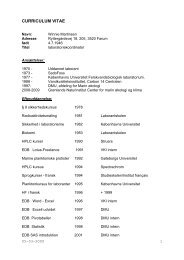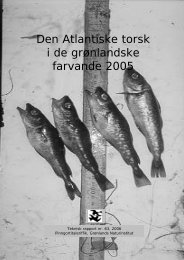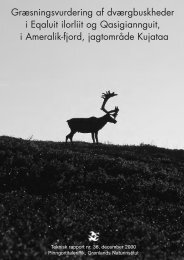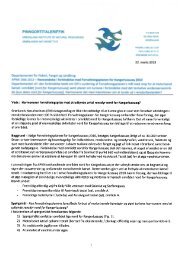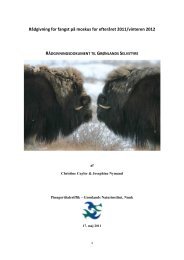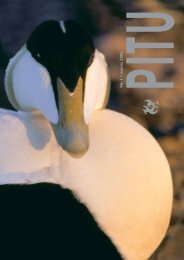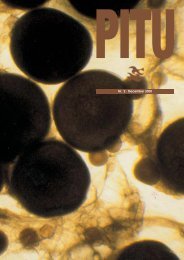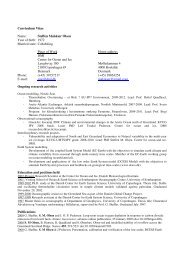Migration and breeding biology of Arctic terns in Greenland
Migration and breeding biology of Arctic terns in Greenland
Migration and breeding biology of Arctic terns in Greenland
Create successful ePaper yourself
Turn your PDF publications into a flip-book with our unique Google optimized e-Paper software.
16<br />
1.2 Objectives<br />
Aim <strong>of</strong> the thesis: The <strong>in</strong>itial aims <strong>of</strong> <strong>and</strong> motivations for my research<br />
were to illum<strong>in</strong>ate a number <strong>of</strong> issues regard<strong>in</strong>g the <strong>biology</strong> <strong>of</strong> the <strong>Arctic</strong><br />
tern <strong>in</strong> Greenl<strong>and</strong>, particularly from a management perspective. Basic<br />
questions, like “What is the current status <strong>of</strong> the <strong>Arctic</strong> tern population<br />
<strong>in</strong> Greenl<strong>and</strong> ?”, “What is the key prey species for <strong>Arctic</strong> <strong>terns</strong> <strong>in</strong> Greenl<strong>and</strong><br />
?” <strong>and</strong> “Do <strong>Arctic</strong> <strong>terns</strong> relay <strong>in</strong> the <strong>Arctic</strong> ?” were unanswered. Later<br />
<strong>in</strong> the process, technological advances rapidly reduced the mass <strong>of</strong> geolocators,<br />
<strong>and</strong> allowed the <strong>Arctic</strong> tern to be targeted as a study subject, <strong>and</strong><br />
the focus <strong>of</strong> my research broadened to also <strong>in</strong>clude this aspect.<br />
Aim <strong>of</strong> the synopsis: The aim <strong>of</strong> this synopsis is to present background<br />
<strong>in</strong>formation on the <strong>biology</strong> <strong>of</strong> the <strong>Arctic</strong> tern <strong>and</strong> highlight how the results<br />
<strong>of</strong> this work have contributed to an improved underst<strong>and</strong><strong>in</strong>g <strong>of</strong> this<br />
species, either globally or specifi cally <strong>in</strong> Greenl<strong>and</strong>. In this context, the<br />
synopsis also <strong>in</strong>cludes results generated dur<strong>in</strong>g the course <strong>of</strong> my research,<br />
but not presented <strong>in</strong> the manuscripts – especially those relat<strong>in</strong>g to issues<br />
specifi c to Greenl<strong>and</strong>.<br />
1.3 Distribution<br />
The <strong>Arctic</strong> tern has a circumpolar distribution between the Boreal <strong>and</strong><br />
High <strong>Arctic</strong> zones. The <strong>breed<strong>in</strong>g</strong> range <strong>in</strong> Greenl<strong>and</strong> is large (more than<br />
350,000 km 2 ), <strong>and</strong> the species is found <strong>breed<strong>in</strong>g</strong> <strong>in</strong> a variety <strong>of</strong> habitats.<br />
In Greenl<strong>and</strong>, <strong>Arctic</strong> <strong>terns</strong> are found <strong>breed<strong>in</strong>g</strong> throughout the country. In<br />
West Greenl<strong>and</strong>, the <strong>Arctic</strong> tern shows a patchy distribution with large<br />
gaps evident. The core <strong>breed<strong>in</strong>g</strong> areas are <strong>in</strong> Disko Bay <strong>and</strong> <strong>in</strong> Upernavik<br />
District (Boertmann et al. 1996, Egevang <strong>and</strong> Boertmann 2003). In East<br />
Greenl<strong>and</strong>, the colonies are fewer, more scattered, <strong>and</strong> smaller than <strong>in</strong><br />
West Greenl<strong>and</strong>. Typically, colonies <strong>in</strong> Greenl<strong>and</strong> are found at small, isolated<br />
islets along the coast, <strong>and</strong> range from a few tens <strong>of</strong> pairs to a few<br />
hundred pairs. Large colonies <strong>of</strong> more than 2,000 pairs are rare, <strong>and</strong> even<br />
solitary <strong>breed<strong>in</strong>g</strong> has been recorded <strong>in</strong> Greenl<strong>and</strong> (Boertmann 1994).<br />
1.4 Population status <strong>in</strong> Greenl<strong>and</strong><br />
The total world population <strong>of</strong> <strong>Arctic</strong> <strong>terns</strong> is estimated at 1 to 2 million<br />
pairs (Lloyd et al. 1991). Global estimates <strong>of</strong> the <strong>Arctic</strong> tern population are<br />
rough, however, <strong>and</strong> some large populations (e.g. <strong>in</strong> Russia <strong>and</strong> Alaska<br />
are diffi cult to estimate (Wetl<strong>and</strong>s International 2006).<br />
Prior to 2002, there was little effort to monitor the <strong>Arctic</strong> tern population<br />
<strong>in</strong> Greenl<strong>and</strong>. Counts were opportunistic <strong>and</strong> only performed <strong>in</strong> s<strong>in</strong>gle<br />
years. The total <strong>Arctic</strong> tern population <strong>in</strong> Greenl<strong>and</strong> is estimated to <strong>in</strong>clude<br />
at least 65,000 pairs (Egevang <strong>and</strong> Boertmann 2003), but limited data<br />
is available. However, three studies provide <strong>in</strong>formation that can be used<br />
to address population status: Salomonsen (1950) visited Kitsissunnguit,<br />
the largest <strong>Arctic</strong> tern colony <strong>in</strong> Greenl<strong>and</strong>, for a short (1 ½ day) period <strong>in</strong><br />
1949, <strong>and</strong> estimated the population to be 100,000 pairs. This high number<br />
<strong>of</strong> <strong>breed<strong>in</strong>g</strong> birds has never been encountered aga<strong>in</strong> <strong>in</strong> censuses conduct-





